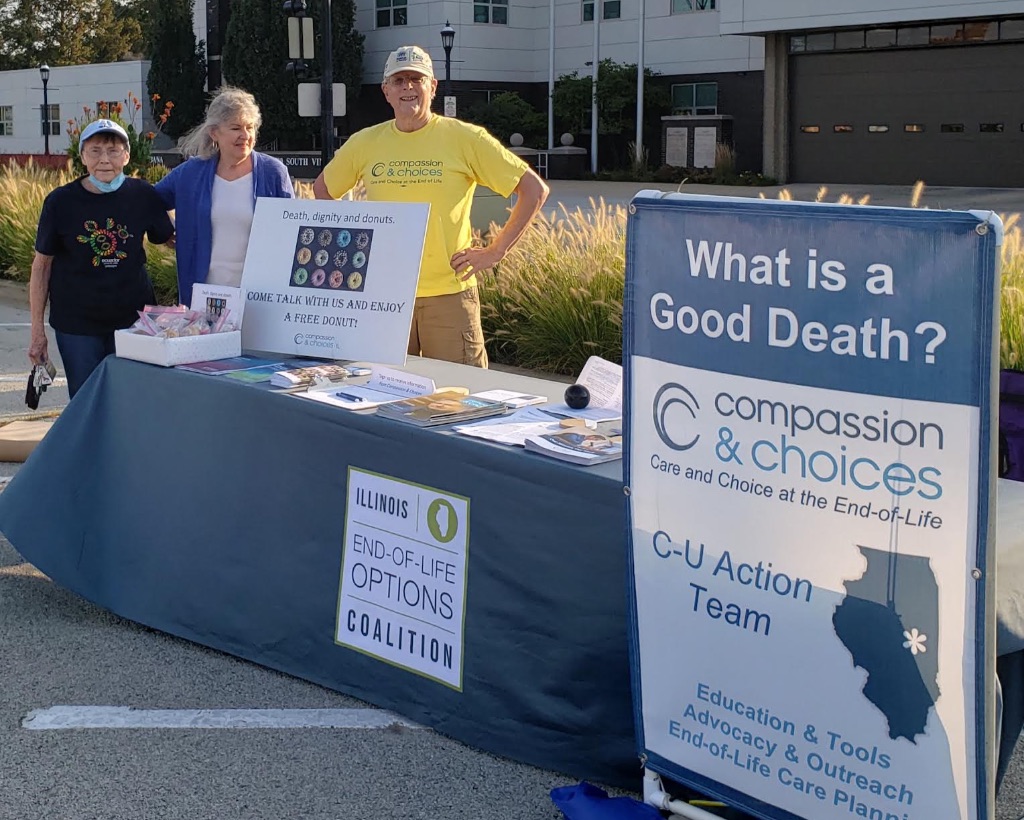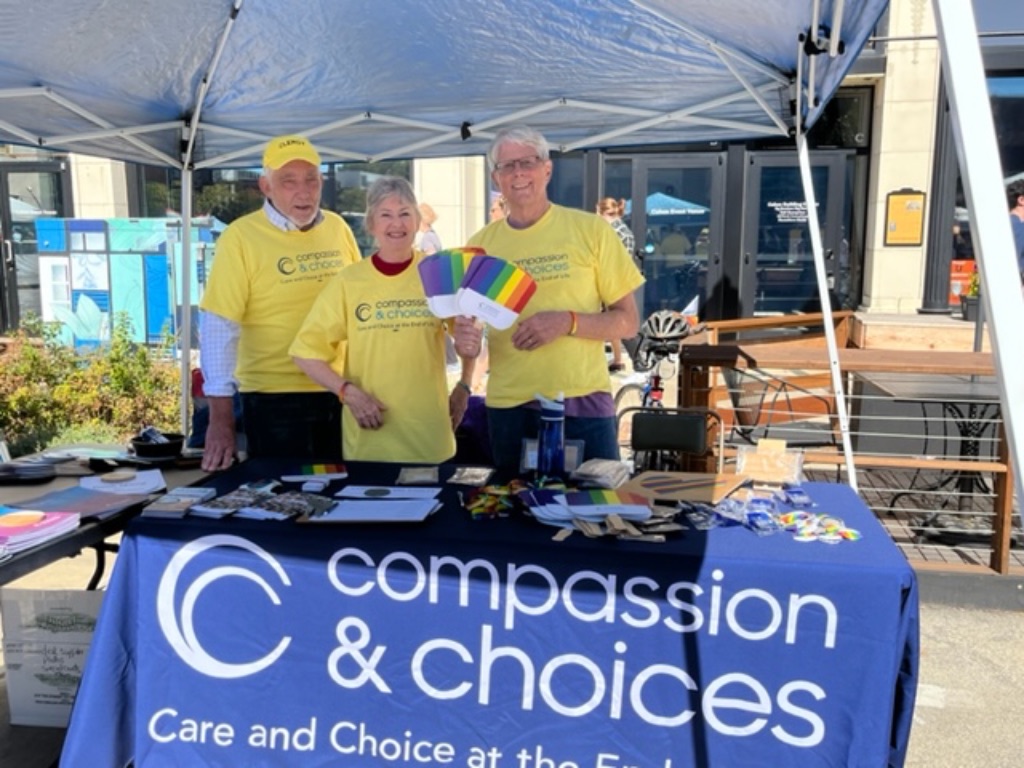For many people, death is a topic far from their minds and conversations. But the Compassion & Choices organization wants to change that, and what better time to talk about your options when dying, than a Monday morning. This organization works hard to empower people to take control of their agency surrounding their end-of-life care by providing education, resources, and legislative efforts. Jim Hannum, a volunteer for the Compassion & Choices Champaign-Urbana Action Team, was kind enough to answer some of my questions around this tough subject.
Smile Politely: Can you introduce yourself?
Jim Hannum: I am Jim Hannum. I volunteer as the Compassion & Choices Action Team leader for the Champaign-Urbana area. I am a retired clinical psychologist and a retired Clinical Professor from the University of Illinois. My wife, Sandy, and I have lived in Urbana since 1982. Our two children went to Urbana schools, and both also graduated from the University of Illinois.
SP: Can you tell me about the Compassion & Choices organization and your role there?
Hannum: Compassion & Choices is the nation’s oldest, largest and most active nonprofit organization working to improve care, expand options and empower everyone to chart their end-of-life journey. In Illinois, there are eight Compassion & Choices Action Teams, representing most of the regions in the state, and one statewide attorney action team. These Action Teams promote educational events, provide speakers and information about end-of-life issues, and engage local legislators on end-of-life issues. I lead the Action Team in this area. We are currently advocating in support of medical aid in dying authorization in Illinois. This would allow an eligible adult with a terminal prognosis the option to request a prescription from their physician to die peacefully in their sleep.
SP: You have a diverse variety of Leadership Councils. Why is it important to have these groups represented this way?
Hannum: Compassion & Choices recognizes that end-of-life needs and knowledge have been reserved to those who are privileged to have access to high quality health care and education. This information may not always be distributed to medically underserved populations, and there are often end-of- life care inequities within traditionally marginalized groups. To better understand community needs, to gain knowledge and direction from members of these communities, and to better advocate for equitable end-of-life options within these groups, Compassion & Choices has developed a number of leadership councils. These leadership councils include the African American Leadership Council, the Asian American, Native Hawaiian and Pacific Islander Leadership Council, the Latino Leadership Council, and the LBGTQ+ Leadership Council. In addition, Compassion & Choices has developed a Healthcare Advisory Council to serve as liaisons to various medical communities on end-of-life care.
SP: What is the most common misconception about death and dying?
Hannum: Our society tends to treat death as the enemy rather than recognizing it as a normal, expected part of life. In viewing death as an enemy, people living with a terminal diagnosis may not have thought about the balance between quantity and quality of life when it comes to choosing the care they want. While each person must make their own choices given their values and circumstances, Compassion & Choices works to make sure people can choose whatever care aligns with their wishes. Some of these options include, palliative care, hospice care, voluntarily stopping of eating and drinking, palliative sedation and (in Washington D.C. and ten states, but not Illinois) medical aid in dying.

SP: Why do you think people avoid talking about death and are there consequences to this?
Hannum: Death is associated with loss and grieving; strong emotions that most of us avoid. The consequences of this avoidance, however, are that people don’t make important plans (like completing wills or designating a healthcare power of attorney) and learn about options for compassionate care as death approaches. When a person’s end-of-life wishes are not thought through or communicated to family members or medical professionals, they are less likely to be followed.
SP: This work must be challenging, what are some of the highs and lows of working in this space?
Hannum: The gratifying aspect of this work is seeing and reading stories about individuals who faced their deaths squarely and communicated their wishes clearly to their families and caregivers, thus allowing their community to compassionately support them through the dying process. An example is the story our local member, Rae Spooner, shared with us about her husband’s (Ray) end of life choices after he was diagnosed with ALS. The loving and compassionate ways the Spooner family supported Ray’s choices as he was dying were a model for us all. A sad aspect is hearing stories of people who received invasive or painful medical interventions, with no real chance of improvement, at enormous cost to the quality of their final weeks and months of life. Or people who faced long, painful suffering as they died, instead of seeking relief through palliative care and hospice care.
SP: What is your favorite way to decompress in the summer in Champaign-Urbana?
Hannum: I love swimming in the outdoor pools at the ARC on campus and Crystal Lake pool. I’m a Master Gardener and enjoy working in the Idea Garden in Urbana and the Randolph Street Community Garden in Champaign. Eating outdoors with friends is also a fun thing to do in summer.
SP: How does Compassion & Choices empower people to reclaim their voice and agency?
Hannum: A central aspect of Compassion & Choices’ mission is helping each person claim their voice to make informed choices about their end of life. Promoting accessible options such as palliative care, hospice care, and medical aid in dying (where available), are key goals. We advocate for state and federal legislation for better end of life care and more end-of-life options, provide legal advocacy to help protect end of life choices, educate the medical community, and promote educational resources to many different communities.
SP: Talking about end of life can be overwhelming, where is a good place to start?
Hannum: There are excellent resources on the Compassion & Choices website. Some of these resources include an end-of-life consultation service, information about advance care planning, advance directives, dementia care, and voluntarily stopping of eating and drinking. Another useful resource is The Conversation Project website.
SP: Anything else you would like to add?
Hannum: In Illinois, we are advocating for the adoption of medical aid in dying legislation, to join the other ten states where it is authorized (California, Colorado, Hawaii, Maine, Montana, New Mexico, New Jersey, Oregon, Vermont, and Washington), as well as Washington, D.C. Collectively, these 11 jurisdictions represent one out of five U.S. residents (22%) and have decades of combined experience successfully implementing this medical practice, starting with Oregon in 1997. We hope that Illinois will adopt legislation enabling people access to this option if they wish to choose it.








